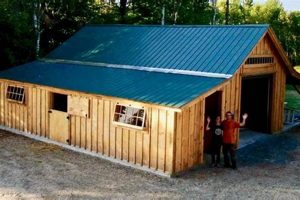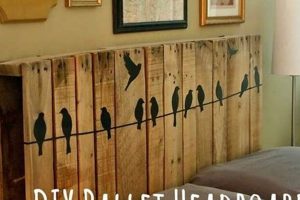A structure designed to shield a children’s play area filled with sand from the elements and unwanted debris, often constructed by the owner rather than purchased pre-made, provides protection and maintains cleanliness. Examples include a hinged wooden lid, a fitted tarp secured with elastic cords, or a segmented folding cover. These covers prevent rain accumulation, deter animals, and minimize the introduction of leaves and other environmental contaminants.
Implementing a protective barrier for a sandbox offers several advantages. It extends the usability of the play area by preventing the sand from becoming saturated and unusable after rainfall. It also reduces the need for frequent sand replacement due to contamination from organic matter or animal waste. Historically, simple covers such as cloths or boards were used; modern iterations often incorporate more durable materials and sophisticated designs for enhanced functionality and aesthetic appeal.
The following sections will delve into various materials suitable for creating such a barrier, explore different design options, and provide step-by-step instructions for constructing a robust and effective solution, enhancing the longevity and enjoyment of the outdoor play space.
Essential Construction Guidelines
The construction of a protective barrier for a children’s sand-filled play area requires careful consideration of materials, design, and environmental factors. The following guidelines provide essential information for ensuring a durable and effective structure.
Tip 1: Material Selection is Paramount: Opt for weather-resistant materials such as treated lumber, marine-grade plywood, or durable synthetic fabrics. Untreated wood is susceptible to rot and insect infestation, significantly reducing the lifespan of the structure. Consider the local climate when choosing materials.
Tip 2: Accurate Measurements are Critical: Precisely measure the sandbox dimensions before commencing construction. Undersized barriers will leave gaps, allowing contaminants to enter. Oversized barriers may be unwieldy and aesthetically displeasing. Create a detailed schematic based on accurate measurements.
Tip 3: Secure Fastening Mechanisms are Essential: Utilize robust hinges, latches, and fasteners to ensure the barrier remains securely closed. Weak or inadequate hardware can result in the barrier being easily dislodged by wind or unauthorized access. Consider using tamper-resistant hardware for added security.
Tip 4: Proper Ventilation is Important: Incorporate ventilation holes or gaps into the design to prevent moisture buildup within the sandbox. Stagnant moisture promotes the growth of mold and mildew, compromising the cleanliness of the sand. Ensure ventilation openings are screened to prevent insect intrusion.
Tip 5: Weight Considerations are Necessary: Design the barrier with manageable weight in mind. Overly heavy barriers are difficult to lift and maneuver, particularly for children or individuals with limited strength. Consider using lightweight materials or segmented designs to reduce the overall weight.
Tip 6: Safety Features are Mandatory: Implement safety features such as rounded edges, smooth surfaces, and locking mechanisms to prevent injuries. Sharp edges pose a cutting hazard, while unsecured barriers can potentially trap or injure children. Regularly inspect the barrier for any signs of damage or wear.
Tip 7: Drainage Considerations are Beneficial: If using a solid barrier, incorporate a slight slope to facilitate water runoff. Standing water on the surface of the barrier can accelerate material degradation. Alternatively, consider using a permeable fabric barrier that allows water to drain through.
Adhering to these guidelines ensures a safe, durable, and effective structure, protecting the play area and extending its usability. Careful planning and execution are crucial for achieving optimal results.
The subsequent sections will provide detailed instructions on specific construction techniques and design variations, enabling the creation of a customized solution tailored to individual needs and preferences.
1. Material Durability
Material durability is a crucial determinant of the long-term effectiveness and overall cost-efficiency of any protective structure designed for a children’s play area filled with sand. The choice of materials directly impacts the structure’s resistance to environmental factors and its ability to withstand regular use. Selecting appropriate materials is paramount to ensuring the sandbox remains protected and usable for an extended period.
- Resistance to Moisture and Decay
The primary function of a protective barrier is to shield the sand from precipitation. Therefore, the chosen material must exhibit high resistance to moisture absorption and subsequent decay. Treated lumber, particularly lumber pressure-treated with preservatives, resists rot and fungal growth, significantly extending the life of the cover. Untreated wood, in contrast, will rapidly deteriorate when exposed to the elements, requiring frequent replacement and increased maintenance.
- Protection Against Insect Infestation
Certain wood species are susceptible to insect infestation, which can compromise the structural integrity of the barrier. Termites and other wood-boring insects can quickly weaken the material, leading to premature failure. Selecting insect-resistant materials, such as cedar or redwood, or applying insecticidal treatments, can mitigate this risk and prolong the lifespan of the cover.
- Withstanding UV Degradation
Prolonged exposure to ultraviolet (UV) radiation from sunlight can degrade many materials, causing them to become brittle, discolored, and structurally weak. Synthetic fabrics, such as UV-resistant tarpaulins or specialized outdoor textiles, are designed to withstand UV degradation, ensuring they maintain their integrity and protective qualities over time. When using wood, application of a UV-resistant sealant or paint can offer a degree of protection.
- Structural Integrity Under Load
The chosen material must possess sufficient strength to withstand the weight of accumulated rainwater, snow, or debris. Furthermore, it should be able to withstand the stresses associated with regular opening and closing. Thicker, more robust materials, such as marine-grade plywood or solid lumber, provide greater structural integrity and resistance to deformation compared to thinner or less durable alternatives. The supporting framework, if applicable, must also be designed to distribute weight evenly and prevent sagging or collapse.
The correlation between material durability and the longevity of a sand-filled play area’s protective barrier is undeniable. Choosing appropriate materials, taking into account factors such as moisture resistance, insect infestation, UV degradation, and structural integrity, results in a long-lasting, cost-effective solution. This proactive approach minimizes maintenance, reduces the need for
frequent replacements, and ensures the continuous usability of the play area for children.
2. Accurate Dimensions
The effective design and construction of a protective barrier for a children’s sand-filled play area relies critically on precise measurement of the existing sandbox structure. Inaccurate dimensions directly compromise the intended functionality of the barrier, potentially negating its protective capabilities. A cover constructed with dimensions smaller than the sandbox perimeter leaves exposed gaps, allowing entry of rainwater, debris, and animals. Conversely, an oversized cover may prove unwieldy, aesthetically unappealing, and potentially unsafe due to improper fit and potential for instability. Real-world examples demonstrate this correlation: a cover built with dimensions underestimated by even a single inch can render the barrier useless in preventing debris accumulation; a cover that is over dimensioned creates gaps leading to uneven loading and potential structural collapse.
The practical application of accurate dimensions extends beyond basic fit. Precise measurements inform material quantities, minimizing waste and reducing project costs. They are also essential for determining hinge placement, fastener requirements, and overall structural design. For instance, a hinged cover necessitates accurate width measurements to ensure proper opening and closing mechanisms. Similarly, determining the exact perimeter allows for precise calculation of material needed for edging or weather stripping, further enhancing the barrier’s protective function. Furthermore, a careful accounting of dimensions allows for pre-fabrication of some or all barrier elements, reducing on-site construction time and complexity. When calculating the appropriate cover overhang, ensuring precise measurements is important to allow enough of a gap for simple fitting.
In summary, accurate dimensions represent a foundational element in the process of creating an effective and durable protective structure for a childrens sandbox. Failure to prioritize precise measurement leads to compromised functionality, increased material waste, and potential safety hazards. Adherence to dimensional accuracy ensures the barrier fulfills its intended purpose, extending the lifespan of the sandbox and maintaining a safe and clean play environment. While seemingly straightforward, the focus on dimensional accuracy is vital and allows for other key aspects of design, such as structural integrity, to be properly addressed.
3. Secure Fastenings
Secure fastenings are integral to the functional efficacy and safety of any barrier created to protect a sand-filled children’s play area. The absence of robust and appropriately selected securing mechanisms directly compromises the integrity of the barrier, rendering it susceptible to displacement by wind, unauthorized access by animals or children, and potential structural failure. The correlation between insufficient or inadequate fasteners and the compromised protection of the sand is causative; poorly secured covers are prone to dislodgement, allowing contaminants to enter the sand and diminishing its usability. Real-world examples of such failures include covers constructed with inadequate latches that are easily opened by wind gusts or curious children, resulting in the sand becoming contaminated with leaves, debris, or animal waste.
The selection and implementation of secure fastenings involve a nuanced understanding of the environmental conditions and the intended use of the sandbox. The type of latch or fastening mechanism must be appropriate for the weight and size of the cover, the frequency of use, and the potential for tampering. Hinges, for example, should be robust and corrosion-resistant to withstand repeated opening and closing, while latches should be child-resistant yet easily operable by adults. The placement of these fastenings must also be strategic, ensuring even distribution of force and preventing localized stress points that could lead to material failure. Considering the weight of the materials being used can give information about how many fasteners are needed.
In summary, secure fastenings represent a non-negotiable component of a well-designed barrier for sand-filled children’s play areas. Their presence or absence directly determines the level of protection afforded to the sand, the longevity of the cover itself, and the overall safety of the play environment. Proper selection, installation, and maintenance of secure fastenings are essential for ensuring the cover fulfills its intended purpose: to protect the sand from contamination and provide a safe and enjoyable play space for children. While the barrier material and structural support have key functions, so do the fasteners and are a crucial element.
4. Ventilation Provisions
The inclusion of ventilation provisions within a homeowner-constructed sand-filled play area barrier directly affects the quality and longevity of the sand itself and the structural integrity of the barrier. The absence of adequate air circulation fosters an environment conducive to the proliferation of mold, mildew, and bacteria, leading to health hazards for children and accelerated decomposition of organic matter within the sand. Furthermore, trapped moisture can cause wooden components of the barrier to rot and metal components to corrode, diminishing the structure’s lifespan. Real-world examples show barriers constructed without ventilation exhibiting damp, discolored sand and weakened structural elements within a relatively short period, necessitating frequent sand replacement and costly repairs.
The practical application of ventilation strategies in these barriers involves incorporating strategically placed openings to facilitate airflow. These openings can take various forms, including small holes drilled in the cover, gaps intentionally left between planks, or the integration of screened vents. The size and placement of these ventilation points must balance the need for airflow with the necessity of preventing the entry of insects, debris, and small animals. Furthermore, the design should consider the prevailing wind direction and the surrounding environment to maximize ventilation effectiveness without compromising the cover’s primary function of protection from the elements. A practical example involves designing a cover with a slight overhang and small screened vents on the sides, allowing for continuous air circulation while preventing rainwater from directly entering the sandbox.
In summary, ventilation provisions represent a critical design consideration when creating a sand-filled play area barrier. Failing to incorporate adequate ventilation results in compromised sand quality, accelerated structural deterioration, and potential health risks. Addressing ventilation needs through thoughtful design and implementation ensures a safer, more hygienic, and longer-lasting play environment for children. The effective implementation of ventilation demonstrates a holistic approach to barrier design, acknowledging the interconnectedness of various design elements in achieving the overall objective of creating a safe and enjoyable play area.
5. Weight Management
Weight management constitutes a crucial consideration in the design and construction of a protective structure for a children’s sand-filled play area. The weight of the barrier directly affects its ease of use, safety, and long-term structural integrity. A cover that is excessively heavy poses challenges for operation, particularly for children or individuals with limited physical strength, and can create safety hazards. Conversely, a cover that is too light might lack sufficient robustness to withstand environmental conditions or resist unauthorized access. Thus, a balance must be struck between structural strength and ease of handling.
- Material Selection’s Influence on Weight
The materials chosen for construction exert a significant influence on the overall weight of the barrier. Dense hardwoods, while offering excellent durability, contribute substantially to the weight of the structure. Lighter alternatives, such as softwood lumber or composite materials, can reduce the overall weight without necessarily compromising structural integrity. A practical example includes using cedar, which is naturally decay-resistant but lighter than oak, or employing a framework of aluminum tubing clad with a lightweight, durable fabric. The design process necessitates a careful evaluation of the trade-offs between material density, cost, and long-term performance.
- Design for Reduced Weight: Sectional Construction
A segmented design approach represents a viable strategy for mitigating the weight burden of a large barrier. Instead of constructing a single, monolithic cover, dividing the structure into smaller, manageable sections allows for easier lifting and maneuvering. Each section can be individually hinged or secured, providing flexibility in accessing the sandbox while reducing the overall weight lifted at any given time. For example, a sandbox cover could be divided into four hinged quadrants, each weighing significantly less than a single, full-sized cover. This approach enhances user-friendliness and minimizes the risk of strain or injury.
- Hardware and Support Mechanisms
The choice of hardware and support mechanisms contributes to the overall weight and functionality of the barrier. Heavy-duty hinges and latches, while providing enhanced security, add to the structure’s total weight. Similarly, robust support frames made of heavy lumber or metal increase the weight burden. Conversely, lightweight hinges and fasteners, combined with a streamlined support framework, can minimize the weight impact without sacrificing structural integrity. Examples include using aluminum hinges instead of steel or employing a truss-style support structure to distribute weight efficiently. The selection of hardware should prioritize functionality and durability while minimizing unnecessary weight.
- Ergonomic Considerations in Design
Beyond the physical weight of the barrier, ergonomic considerations play a crucial role in weight management. A well-designed cover incorporates features that facilitate easy lifting and maneuvering, even if the structure is relatively heavy. These features might include strategically placed handles, levers, or counterbalancing mechanisms that reduce the effort required to operate the cover. For instance, incorporating a spring-assisted lifting mechanism can significantly reduce the force needed to open and close a heavy cover. The integration of ergonomic principles enhances user comfort and safety, particularly for individuals with limited strength or mobility.
In conclusion, effective weight management is an indispensable aspect of sandbox barrier construction. Thoughtful material selection, sectional design, appropriate hardware choices, and ergonomic considerations contribute to a barrier that is both durable and user-friendly. A well-managed weight profile enhances the safety and accessibility of the sandbox while minimizing the risk of strain or injury, thereby extending the usability and enjoyment of the play area.
6. Safety Implementation
Safety implementation is intrinsically linked to the successful creation and utilization of any homeowner-constructed protective barrier for a childrens sand-filled play area. Inadequate attention to safety considerations can result in physical harm to children, structural failure of the barrier, and diminished utility of the play area. A direct causal relationship exists between safety implementation and the well-being of children using the sandbox; absence of appropriate safety measures directly increases the likelihood of injury. A poorly designed or constructed cover may feature sharp edges, unsecured hinges, or excessive weight, all of which pose significant risks to children. For example, a heavy cover lacking a secure latching mechanism could unexpectedly fall, causing serious injury. Similarly, sharp edges or splinters on untreated wood can cause cuts and abrasions. The prioritization of safety is therefore not merely a desirable attribute but a fundamental requirement.
Practical application of safety principles in protective barrier construction involves several key areas. Edge treatment, using rounded edges and smooth surfaces, minimizes the risk of cuts and abrasions. Secure fastening systems, employing robust hinges and child-resistant latches, prevent accidental closures and unauthorized access. Weight management, ensuring the cover is easily manageable by adults, reduces the risk of strain or injury during operation. Additionally, proper ventilation, through the incorporation of screened vents, prevents moisture buildup and minimizes the risk of mold and mildew growth. Furthermore, selection of non-toxic materials, such as treated lumber that is certified safe for playground use, minimizes the risk of chemical exposure. A comprehensive approach to safety necessitates integrating these considerations into every stage of the design and construction process.
In summary, safety implementation is not merely a supplementary aspect of a homeowner-built sandbox cover but an indispensable component, directly influencing the safety and enjoyment of the play area. Overlooking safety considerations results in elevated risks of injury and diminished functionality. Adherence to established safety protocols, through careful material selection, thoughtful design, and meticulous construction, is essential for creating a secure and enjoyable play environment for children. Ignoring these factors ultimately undermines the purpose of providing a safe space, shifting risk from preventing harm to causing it.
7. Drainage Facilitation
Drainage facilitation represents a critical, often overlooked, component in the design and construction of a homeowner-built protective barrier for a children’s sand-filled play area. The absence of adequate drainage mechanisms directly correlates with increased moisture accumulation within the sandbox, fostering an environment conducive to the growth of mold, mildew, and bacteria. This excess moisture saturates the sand, rendering it unusable and potentially hazardous to children’s health. The causative link between poor drainage and compromised sand quality is undeniable. A real-world example involves a sandbox cover constructed from solid wood with no drainage provisions; af
ter a rain event, the trapped water permeated the sand, creating a breeding ground for bacteria and rendering the play area unusable until the sand was replaced.
Implementing effective drainage strategies involves several practical considerations. The selection of materials plays a key role; permeable fabrics or materials with natural water-shedding properties are preferred. Design modifications, such as incorporating a slight slope to the cover surface or integrating drainage holes, facilitate water runoff and prevent ponding. Furthermore, the underlying sandbox structure should also promote drainage, preventing water from accumulating beneath the sand. For instance, constructing the sandbox base with gravel or installing a perforated liner allows water to drain away from the sand, minimizing moisture retention. The practical significance of these drainage considerations lies in extending the usable lifespan of the sand, reducing maintenance requirements, and ensuring a safe and hygienic play environment for children.
In summary, drainage facilitation is an essential element in the design and construction of a protective cover for a sand-filled play area. Neglecting this aspect results in compromised sand quality, increased maintenance, and potential health risks. Implementing effective drainage strategies, through appropriate material selection, design modifications, and attention to the underlying sandbox structure, ensures a safer, more hygienic, and longer-lasting play environment. While the visual and structural aspects of the cover are important, the often-unseen element of proper drainage is critical to the overall success and longevity of the sandbox and its protective barrier.
Frequently Asked Questions
The following questions address common concerns and misconceptions regarding the construction and maintenance of protective barriers for children’s sand-filled play areas. The information provided aims to offer clarity and guidance for optimal design and implementation.
Question 1: What is the most durable material for constructing a protective play area barrier?
The optimal material balances weather resistance, structural integrity, and safety. Treated lumber (specifically pressure-treated) offers good resistance to rot and insect infestation, but ensure it is certified safe for playground use. Marine-grade plywood provides excellent water resistance and structural stability. Durable synthetic fabrics offer lightweight and weather-resistant solutions, but their long-term durability may vary depending on the specific material and UV exposure.
Question 2: How can one ensure the barrier is adequately secured against unauthorized access?
Employ robust latching mechanisms designed to be child-resistant yet easily operable by adults. Consider using tamper-resistant hardware to prevent easy removal or manipulation of the latch. Ensure the latch is securely fastened to both the cover and the sandbox frame. Regular inspection and maintenance of the latching mechanism are crucial to ensure its continued effectiveness.
Question 3: What are the recommended methods for providing adequate ventilation within the sandbox?
Incorporate strategically placed ventilation openings, such as small holes or screened vents, to promote airflow and prevent moisture buildup. Ensure these openings are screened to prevent the entry of insects or small animals. Position the vents in locations that facilitate cross-ventilation, maximizing airflow without compromising the cover’s protective function. Balance ventilation with the need to prevent excessive sand from blowing out in windy conditions.
Question 4: How can one minimize the weight of the play area barrier while maintaining structural integrity?
Select lightweight yet durable materials, such as cedar or composite lumber. Employ a sectional design approach, dividing the cover into smaller, manageable sections. Utilize a lightweight support framework, such as aluminum tubing or a truss-style structure. Consider using ergonomic handles or lifting mechanisms to facilitate easier operation, even if the cover is relatively heavy.
Question 5: What are the essential safety features to incorporate into the cover design?
Round all edges and corners to minimize the risk of cuts and abrasions. Ensure the cover is properly hinged and secured to prevent accidental closures. Select non-toxic materials certified safe for playground use. Design the cover to be easily manageable by adults, preventing strain or injury during operation. Regularly inspect the cover for any signs of damage or wear, addressing any issues promptly.
Question 6: What drainage solutions should one implement to prevent water accumulation within the sandbox?
Incorporate a slight slope to the cover surface to facilitate water runoff. Drill drainage holes in the cover, ensuring they are sized appropriately to allow water to drain without allowing sand to escape. Consider using a permeable cover material that allows water to drain through. Ensure the underlying sandbox structure also promotes drainage, preventing water from accumulating beneath the sand.
In summary, careful consideration of materials, safety features, and operational aspects is paramount in creating a durable, safe, and effective protective barrier for a sand-filled play area. Addressing these questions proactively contributes to a longer-lasting and more enjoyable play environment.
The following section will discuss advanced design considerations, providing guidance on customizing barriers to specific needs and preferences.
Conclusion
The preceding exploration has detailed the critical considerations involved in creating a durable and safe barrier for children’s sand-filled play areas. Material selection, accurate dimensioning, secure fastening, ventilation, weight management, safety implementation, and drainage facilitation all contribute to the overall efficacy of the structure. Each element requires careful planning and execution to ensure optimal performance.
Effective implementation of these principles protects children and the play area, promoting longevity and usability. A thoughtfully constructed barrier provides peace of mind and long-term enjoyment. Investing time and resources into proper construction yields a significant return in safety and convenience.



![DIY Build: Circular Saw Crosscut Jig PDF Plans [Free] The DIY Hub: Creative Crafts, Repairs & Life Hacks DIY Build: Circular Saw Crosscut Jig PDF Plans [Free] | The DIY Hub: Creative Crafts, Repairs & Life Hacks](https://craftingdiycenter.com/wp-content/uploads/2025/07/th-5916-300x200.jpg)


![Diya Aur Baati Hum: Illuminate Your Home [DIY Guide] The DIY Hub: Creative Crafts, Repairs & Life Hacks Diya Aur Baati Hum: Illuminate Your Home [DIY Guide] | The DIY Hub: Creative Crafts, Repairs & Life Hacks](https://craftingdiycenter.com/wp-content/uploads/2025/07/th-5913-300x200.jpg)
